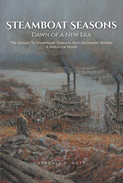
 |
It is the summer of 1865 in this tale told from the perspective of a fictitious steamboat captain and pilot. The captain navigates a volatile period immediately after America's Civil War ends in April 1865. President Lincoln is assassinated, earmarking Reconstruction for failure. The South is broken, yet the North remains virtually economically unscathed. Immigrants and industry are on the rise. With displaced troops to feed and war-torn cities to rebuild, the postbellum economy needs increasingly swift transportation like a failing kidney needs dialysis. The race between the steamboats and the railroads is on throughout the South, Midwest, and West, with greed and intrigue driving the battle.
Society, too, is changing. The South can no longer enslave negroes and is expected to acknowledge their equality through fair wages and equal human rights, something it is ill-equipped to do. The nation contends with physically and mentally damaged men and women, one-armed, shell-shocked, and everything in between. The West wrestles with Indian unrest.
The captain (no other name is ever given) steams into this dramatic epoch in history. A former gunboat pilot for the Union Army, he despises Confederate sympathizers and the mistreatment of negroes. A strong sense of fair play defines his sterling character, as does a commitment to duty and career. Even Ann, a childhood sweetheart and former Civil War nurse, cannot compete with his calling. In a wonderful portrayal of a war-damaged psyche, Ann slips into opium abuse, bought legally in packets of powder at the druggists, as she floats into the margins of society. Another damaged veteran named Bemis, the boat's one-legged chief clerk, flickers intermittently through the pages. Even with the scarcity of able bodies, the captain has a knack for hiring well and gladly employs negroes at full pay, creating inevitable controversies.
The captain steers his workhorse, a freighter-packet steamboat, through history along the Mississippi, Illinois, Cumberland, and Missouri rivers. Three pages of maps allow the finger to travel the steamboat's path. Detailed descriptions of river towns and their roles in history shine. Nashville, the Athens of the South, saw a bloody Union victory and thrums with tension between former foes. The journey to Fort Benton, the Chicago of the Plains, tingles with Indian perils. St. Louis breeds a tricky cholera epidemic. The steamboat chugs on through ice on the Mississippi, boiler disasters, the nascent canal system, the cotton crisis, multiple sabotage attempts by rivals, and the ultimate sabotage by the federal government when it financially backs the railroads at the steamboats' expense.
Gott is well-equipped to deliver this history lesson in story form. Retired from the U.S. Army with combat tours in Operation Desert Storm and Operation Desert Fox, he is Senior Historian at the U.S. Army Combat Studies Institute at Fort Leavenworth, Kansas. Gott has authored sixteen books, primarily military nonfiction, including analyses of America's Civil War. A prequel to this fiction offering introduces the captain, although the current story stands alone just fine.
The author deftly captures the setting and conflicts of the time immediately following the Civil War: the advance of the railroad at the expense of the steamboat, the failure of Reconstruction, the enormous human cost of the Civil War, and the ruthlessness of men determined to preserve profits. He impresses with his extensive knowledge of how a steamboat operates and navigates, the steamboat culture, and the geography and history of dozens of picturesque river towns. Interesting embellishments include a lady's guide to flirting with a fan and how long it takes thousands of buffalo to cross a river (two days).
Gott builds a skeleton of a story on which the clothes of history are hung, a guidebook to the past navigated by a post–Civil War steamboat and its captain. The chronology of events drives the story, with the captain and others along for the ride. The detail-oriented reader with a penchant for steamboats will be pleasurably lost for hours in this well-researched historical novel about the turbulent social, economic, and industrial era immediately following the American Civil War.